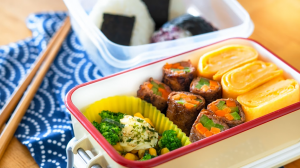Experience a taste of traditional Japanese cuisine with this authentic Tamagoyaki recipe, also known as Japanese rolled omelette. This dish, often served in bento boxes or as a breakfast dish, offers a unique sweet and savory flavor that's surprisingly simple to create in your own kitchen.
Dashi stock and Mirin may not be common in every kitchen. Dashi is a classic Japanese stock used as a base for many dishes, and is typically made from seaweed and bonito flakes. Mirin is a sweet rice wine, similar to sake but with a lower alcohol content and higher sugar content. Both are integral to achieving the authentic taste of Tamagoyaki, so it's worth seeking them out at a local Asian grocery store or online.
Ingredients for the Japanese Rolled Omelette (Tamagoyaki)
Eggs: The base ingredient in any omelette, they provide protein and a smooth texture.
Dashi stock: This stock gives the dish its unique umami flavor.
White sugar: It adds a hint of sweetness to balance the savory elements.
Mirin: A sweet rice wine that contributes to the distinctive taste of Tamagoyaki.
Soy sauce: It adds saltiness and depth of flavor.
Vegetable oil: Used for frying the omelette, ensuring it doesn't stick to the pan.
One reader, Bellina Mcgowan says:





This Japanese rolled omelette recipe is a game-changer! The dashi stock and mirin add a unique depth of flavor, and the omelette rolls up beautifully. It's a delightful addition to any meal and a hit with my family. I love how easy it is to make and how impressive it looks on the plate. Highly recommended!
Techniques Required for Making Japanese Rolled Omelette
How to whisk the egg mixture: Whisk together the eggs, dashi stock, sugar, mirin, and soy sauce until well combined and slightly frothy.
How to roll the omelette: Roll up the omelette from one side to the other as soon as it is set, then continue rolling and adding more egg mixture until the omelette is fully rolled.
How to slice the omelette: Unwrap the rolled omelette and slice it into 6 pieces using a sharp knife.
How To Make Tamagoyaki (Japanese Rolled Omelette)
Enjoy a plate of Tamagoyaki or rolled omelette, made with savory dashi stock, soy sauce, and sweet wine, then pan-fried for a rich fluffy dish.
Serves:
Ingredients
- 4eggs
- 4tbspdashi stock,prepared
- 1tbspwhite sugar
- 1tspmirin,(Japanese sweet wine)
- ½tspsoy sauce
- ½tbspvegetable oil
Instructions
-
Whisk the eggs, dashi stock, sugar, mirin, and soy sauce together in a bowl.
-
Heat ⅓ of the oil in a large nonstick skillet over medium-high heat.
-
Add about ⅓ of the egg mixture and quickly swirl the pan to evenly cover the bottom. Start rolling up the omelette from one side to the other as soon as it is set.
-
Keep the roll to one side, then add another ⅓ of the oil to the skillet and another ⅓ of the egg. Swirl the pan, ensuring the entire bottom is covered, including around and underneath the first roll.
-
Cook until set. Roll up from the side containing the first roll, so that is now at the center.
-
Repeat the process with the remaining oil and egg. Transfer the rolled omelette to a bamboo rolling mat. Roll up tightly and allow to cool for a few minutes.
-
Unwrap the omelette and slice into 6 pieces. Serve and enjoy!
Nutrition
- Calories: 192.86kcal
- Fat: 12.05g
- Saturated Fat: 3.01g
- Trans Fat: 0.06g
- Monounsaturated Fat: 5.84g
- Polyunsaturated Fat: 2.31g
- Carbohydrates: 8.11g
- Fiber: 0.01g
- Sugar: 7.03g
- Protein: 11.68g
- Cholesterol: 320.82mg
- Sodium: 237.91mg
- Calcium: 49.68mg
- Potassium: 156.67mg
- Iron: 1.59mg
- Vitamin A: 137.90µg
- Vitamin C: 0.06mg
How To Make Tamagoyaki (Japanese Rolled Omelette)
Made with savory dashi stock, soy sauce, and sweet wine, enjoy Tamagoyaki or Japanese rolled omelette fried in just 10 minutes for a rich fluffy plate.
Serves:
Ingredients
- 4eggs
- 4tbspdashi stock,prepared
- 1tbspwhite sugar
- 1tspmirin,Japanese sweet wine
- ½tspsoy sauce
- ½tbspvegetable oil
Instructions
-
Whisk eggs, dashi stock, sugar, mirin, and soy sauce together in a bowl.
-
Heat ⅓ of the oil in a large nonstick skillet over medium-high heat. Add about ⅓ of the egg mixture and quickly swirl the pan to evenly cover the bottom. Start rolling up the omelette from one side to the other as soon as it is set.
-
Keep the roll to one side, then add another ⅓ of the oil to the skillet and another ⅓ of the egg. Swirl the pan, ensuring the entire bottom is covered, including around and underneath the first roll. Cook until set. Roll up from the side containing the first roll, so that is now at the center.
-
Repeat the process with the remaining oil and egg. Transfer rolled omelette to a bamboo rolling mat. Roll up tightly and allow to cool for a few minutes.
-
Unwrap the omelette and slice into 6 pieces.
-
Serve warm or cold.
Nutrition
- Calories: 192.86kcal
- Fat: 12.05g
- Saturated Fat: 3.01g
- Trans Fat: 0.06g
- Monounsaturated Fat: 5.84g
- Polyunsaturated Fat: 2.31g
- Carbohydrates: 8.11g
- Fiber: 0.01g
- Sugar: 7.03g
- Protein: 11.68g
- Cholesterol: 320.82mg
- Sodium: 237.91mg
- Calcium: 49.68mg
- Potassium: 156.67mg
- Iron: 1.59mg
- Vitamin A: 137.90µg
- Vitamin C: 0.06mg
Crucial Technique for Perfecting Japanese Rolled Omelette
To ensure your Japanese rolled omelette (Tamagoyaki) has a soft and fluffy texture, avoid overcooking the eggs. Each layer should be just set before you start rolling. This will also make the rolling process easier and prevent the omelette from breaking apart. Additionally, using a bamboo rolling mat not only helps to shape the omelette but also absorbs excess moisture, resulting in a firmer and more appealing final product.
Time-Saving Tips for Making Tamagoyaki
Prepare the ingredients: Gather all the necessary ingredients and tools before starting to cook to streamline the process.
Use a rectangular pan: Using a rectangular pan specifically designed for making tamagoyaki will help you achieve the perfect shape and thickness.
Keep the heat consistent: Maintain a consistent heat level throughout the cooking process to ensure even cooking and prevent burning.
Practice makes perfect: Don't be discouraged if your first attempt isn't flawless. Like any culinary skill, mastering tamagoyaki takes practice and patience.
Invest in a tamagoyaki pan: Consider investing in a tamagoyaki pan with a non-stick surface to make the cooking process smoother and more efficient.
Prep ahead of time: Prepare the egg mixture the night before and store it in the refrigerator to save time on busy mornings.
Substitute Ingredients For Tamagoyaki (Japanese Rolled Omelette) Recipe
eggs - Substitute with silken tofu: Silken tofu can be used as a vegan alternative to eggs in tamagoyaki. It provides a similar texture and can be seasoned to mimic the flavor of eggs.
dashi stock - Substitute with vegetable broth: Vegetable broth can be used as a vegetarian substitute for dashi stock. It adds a savory umami flavor to the tamagoyaki.
white sugar - Substitute with honey: Honey can be used as a natural sweetener in place of white sugar, adding a slightly different flavor profile to the tamagoyaki.
mirin - Substitute with rice vinegar and a pinch of sugar: A combination of rice vinegar and a small amount of sugar can replicate the sweet and tangy flavor of mirin in the tamagoyaki.
soy sauce - Substitute with tamari: Tamari, a gluten-free soy sauce, can be used as a substitute for traditional soy sauce, providing a similar salty and savory flavor to the tamagoyaki.
vegetable oil - Substitute with coconut oil: Coconut oil can be used as a substitute for vegetable oil, adding a hint of coconut flavor to the tamagoyaki.
Presenting Japanese Rolled Omelette for Maximum Appeal
Elevate the Tamagoyaki: Place the sliced tamagoyaki on a beautiful serving platter with a minimalist design to showcase the elegance of the dish.
Garnish with precision: Add a sprinkle of finely chopped chives on top of the tamagoyaki for a pop of color and a touch of freshness.
Incorporate edible flowers: Place a delicate edible flower alongside the tamagoyaki to add a subtle floral note and enhance the visual appeal of the dish.
Utilize traditional Japanese serveware: Present the tamagoyaki on a handcrafted ceramic plate to honor its Japanese heritage and elevate the dining experience.
Accentuate with wasabi: Create a small dollop of wasabi on the side of the plate to provide a hint of heat and complement the flavors of the tamagoyaki.
Emphasize symmetry: Arrange the tamagoyaki slices in a symmetrical pattern on the plate to create a visually striking presentation that reflects precision and attention to detail.
Highlight with a soy sauce drizzle: Carefully drizzle a small amount of soy sauce around the tamagoyaki to add a touch of umami flavor and create an artistic element on the plate.
Incorporate a bamboo leaf: Place a bamboo leaf underneath the tamagoyaki slices to infuse a subtle earthy aroma and add a touch of natural beauty to the presentation.
Essential Tools for Making Tamagoyaki
- Whisk: A kitchen tool used for whipping and mixing ingredients together, often with a handle and a series of loops or wires.
- Nonstick skillet: A type of frying pan with a special coating that prevents food from sticking to the surface, making it easier to cook delicate foods like eggs and fish.
- Bamboo rolling mat: A mat made from bamboo used in Japanese cooking to roll and shape sushi, maki, and tamagoyaki.
Storing and Freezing Tamagoyaki for Later
- Allow the tamagoyaki to cool completely before storing or freezing.
- To store in the refrigerator, wrap the cooled omelette tightly in plastic wrap or place it in an airtight container. It will keep in the fridge for up to 3 days.
- For longer storage, you can freeze the tamagoyaki:
- Wrap the cooled omelette tightly in plastic wrap, then place it in a freezer-safe bag or container.
- Label the bag or container with the date and contents.
- Freeze for up to 1 month.
- To thaw frozen tamagoyaki, transfer it from the freezer to the refrigerator and let it thaw overnight.
- To reheat refrigerated or thawed tamagoyaki:
- Remove the plastic wrap and place the omelette on a microwave-safe plate.
- Cover the plate with a damp paper towel to prevent the omelette from drying out.
- Microwave on high for 30-60 seconds, or until heated through.
- Alternatively, you can reheat the tamagoyaki in a skillet over medium heat until warmed through, about 1-2 minutes per side.
- Slice the reheated omelette into pieces and serve immediately for the best texture and flavor.
How To Reheat Leftover Tamagoyaki
To reheat leftover tamagoyaki, the best method is to use a microwave. Place the slices on a microwave-safe plate and heat them for 15-20 seconds on high power. This will help retain the moisture and prevent the omelette from drying out or becoming rubbery.
Another option is to reheat the tamagoyaki in a steamer. Arrange the slices in a single layer on a heatproof plate and place it in a steamer basket over simmering water. Cover and steam for 1-2 minutes, or until heated through. This method will help maintain the soft, fluffy texture of the omelette.
If you prefer a slightly crispy exterior, you can reheat the tamagoyaki in a non-stick skillet over medium-low heat. Brush the slices with a small amount of vegetable oil and cook for about 30 seconds on each side, or until warmed through and lightly crisp.
For a quick and convenient option, you can also reheat the tamagoyaki in a toaster oven. Place the slices on the toaster oven rack and heat at 350°F (175°C) for 1-2 minutes, or until heated through. Keep a close eye on them to prevent burning.
Regardless of the reheating method you choose, be sure not to overheat the tamagoyaki, as this can cause the eggs to become tough and rubbery. Reheating should be done gently and only until the slices are warmed through, ensuring that the delicate flavor and texture of the omelette are preserved.
Interesting Trivia About Tamagoyaki
The Japanese rolled omelette, or tamagoyaki, is a popular dish in Japan and is often enjoyed as a breakfast or side dish. It is made by rolling together thin layers of seasoned egg to create a delicate and flavorful omelette. The technique of rolling the omelette creates a unique texture and appearance, making it a visually appealing dish. Tamagoyaki is often served with grated daikon radish, soy sauce, or a sprinkle of bonito flakes for added flavor. This dish is not only delicious but also showcases the precision and skill of Japanese culinary artistry.
Is Making Tamagoyaki at Home Cost-Effective?
This Japanese rolled omelette (tamagoyaki) recipe offers a high degree of cost-effectiveness for a household. The use of simple and affordable ingredients like eggs and dashi stock makes it budget-friendly. With an approximate cost of $8, this recipe can serve a family of four, making it a great economical choice. The versatility of this dish also adds value, as it can be enjoyed as a breakfast, snack, or even a part of a bento box. Overall Verdict: 9.
Is Tamagoyaki Healthy or Unhealthy?
The Japanese rolled omelette (tamagoyaki) recipe is a relatively healthy dish, but there are a few aspects that could be improved:
- Eggs are a nutritious source of protein, vitamins, and minerals. However, the recipe uses 4 whole eggs, which may contribute to higher cholesterol intake.
- Dashi stock adds depth and umami flavor, but depending on the type used, it may contain high levels of sodium.
- The recipe includes sugar and mirin, which are sources of added sugars. While the amounts are small, they can still contribute to overall sugar intake.
- Soy sauce is high in sodium, but the recipe only calls for a small amount.
- Vegetable oil is used for cooking, which is a healthier option compared to saturated fats like butter.
To make this recipe even healthier, consider the following suggestions:
- Use 2 whole eggs and 2 egg whites to reduce the cholesterol content while maintaining protein.
- Opt for low-sodium dashi stock or prepare homemade dashi using kombu (kelp) and bonito flakes to control sodium levels.
- Reduce the amount of sugar and mirin, or replace them with natural sweeteners like stevia or erythritol.
- Choose low-sodium soy sauce or replace it with coconut aminos for a lower-sodium alternative.
- Use heart-healthy oils like olive oil or avocado oil for cooking.
- Serve the tamagoyaki with a side of fresh vegetables or a light salad to increase fiber and nutrient intake.
- Incorporate additional herbs and spices, such as scallions or seaweed flakes, to enhance flavor without relying on salt or sugar.
Editor's Opinion on This Japanese Rolled Omelette Recipe
This Japanese rolled omelette (tamagoyaki) recipe is a delightful blend of sweet and savory flavors. The combination of dashi stock, sugar, mirin, and soy sauce creates a rich umami taste that complements the fluffy texture of the eggs. The rolling technique adds a visually appealing touch to the dish. However, to enhance the overall presentation and flavor, consider incorporating finely chopped scallions or a sprinkle of sesame seeds for added depth. Overall, this recipe offers a traditional and satisfying taste of Japanese cuisine.
Enhance Your Tamagoyaki (Japanese Rolled Omelette) Recipe with These Unique Side Dishes:
Similar Dishes to Japanese Rolled Omelette
Ideal Main Courses and Desserts to Serve With Tamagoyaki
Why trust this Tamagoyaki (Japanese Rolled Omelette) Recipe:
This recipe for Japanese rolled omelette, or tamagoyaki, is a traditional and authentic preparation that stays true to the classic flavors and techniques. The use of dashi stock and mirin adds depth and sweetness, while the incorporation of soy sauce provides a savory balance. The method of rolling the omelette in layers creates a visually appealing and texturally delightful dish. With the combination of these ingredients and the precise instructions, users can trust that this recipe will deliver an exquisite and genuine Japanese cuisine experience.
Was this page helpful?
Have your own special recipe to share? Submit Your Recipe Today!














